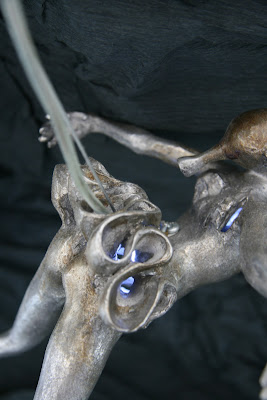Lucciole
( firefliesvia altamura, foggia, italy)
The most of the pieces are wax modeled, metal fused aluminum sculptures or reliefs.
THE MAIN ENTRANCE
Civic number # 25 of Via Altamura Street, Foggia City.
ENTRANCE STAIRCASE AND HALL
Fireflies metamorfosis dance
INTERIOR SPIRAL STAIRCASE "LUCCIOLE" (FIREFLIES) HUNG LAMP
LIVINGROOM FIREPLACE
LYING FIREFLY (DETAIL)
LYING FIREFLY (mirror frame decoration)
INTERIOR GARDEN - MINOTAUR LABIRYNTH / FOUNTAIN GROUP
THE COMMITMENT
In 2012 a couple of clients asked me to develop some art works for a new house they were buying to restore and furnish. The house was located, at Via Altamura street, in a 1700 building located in the Foggia city hostoric center (puglia - Italy) .
From the moment I first visited the house and heard them talk about the house's history I decided it was better to propose them to develop a set of applied atrs pieces instead of making just a few personal art works to hung or place in the house. It was better if they became part of the house as it's sotry was too.
The thing is that the house that laid abandoned for several years used to be a hotel, a little and annonimous hotel named "Albergo Tricolore" (three color hotel) was ambiguous bit not of the indirect reference to the italian flag colors, but because the patriotic name hided the real building's identity, the place was one of the city's brothels.
We talked about the fact that hosts or neighbors would probably speak and ask them about this erotic heritage of the house. I was aware of the fact that even if they wanted to transform the old building into their house the underlying meaningful identity of the past was something that could appear at any time and was impossible to avoid or to hide, as it was part of Foggia's people imaginaries, stories and memories.
HOUSE HISTORIC ARCHIVES RESEARCH
Dati
del censimento del 31 dicembre 1871
(La
popolazione era di 38.138 unità di cui 3.957 vivevano in campagna)
Proprietari
|
518
|
Agrimensori,
avvocati, cantanti, medici, farmacisti, veterinari, ingegneri,
notai, professori, maestri e levatrici
|
287
|
Agricoltori,
ortolani e vignaiuoli
|
440
|
Agricoltori
braccianti
|
3156
|
Braccianti
|
2052
|
Armaioli,
orologiai, orefici, droghieri, merciai ecc.
|
292
|
Barbieri,
bottai, calderai, calzolai, fabbri, falegnami, funai, legatori,
maniscalchi, sarti, stagnai, seggiolari, ecc.
|
1520
|
Carpentieri,
fornaciai, manovali, marmorari, muratori, scalpellini
|
675
|
Studenti
|
627
|
Bovari,
caprai, giumentieri, mozzi di stalla, pastori e stallieri
|
1201
|
Carrettieri,
carrozzieri, cocchieri e vetturini
|
382
|
Impiegati
di banca, municipali, provinciali, statali e privati
|
371
|
Preti
e monache
|
188
|
Ferrovieri
|
306
|
Domestici
|
559
|
Meretrici
|
131
|
Guardie
campestri, municipali e di pubblica sicurezza
|
172
|
This table shows the 1871 Foggia Population Census, indicating the number of prostitutes (meretrici 131) living in the city at that time.
Quadro
delle principali attività foggiane nel 1951
(fonte:
Guida di Foggia, di M.Biccari e M.Loco – tip. G.C.Resta, Bari 1952)
(a
cura di Raffaele De Seneen)
Alberghi
n. 8
"Cicinella"
Via Eolo 5 - 4^ Cat. - Camere 12 - Letti 22 (Cicinella, nome famoso
anche per il rinomato forno-pizzeria)
"Cicolella"
V.le 24 Maggio 60/74 - 3^ Categ. - Camere 84 - Letti 116
"Cicolella"
Via Sabotino 14 - 4^ Categ. - Camere 14 - Letti 32
"Moderno"
Via Noto 8 - 4^ Categ. - Camere 11 - Letti 18 (Via Noto, da Via
Cavallucci a Via Orientale; in parte non esiste più. Fino al 1995
circa giungeva con Via Della Repubblica)
"Roma"
P.zza Lanza 19 - 3^ Categ. - Camere 52 - Letti 64
"Russo"
C.so Cairoli 5 - 4^ Categ. - Camere 12 - Letti 26
"Sarti"
Via Monfalcone 1 - 2^ Categ. - Camere 10 - Letti 162
"Venezia"
Via Piave 42 - 4^ Categ. - Camere 12 - Letti 20
Locande
n. 5 (oggi del tutto scomparse)
"Adua"
Via S. Lazzaro 10 - Camere 4 - Letti 11
"Commerciale"
P.zza C. Battisti 6 - Camere 6 - Letti 17
"Tricolore"
Via S. Altamura 25 - Camere 8 - Letti 18
"Trifiletti"
Via Fiume 14 - Camere 13 - Letti 33
"Venezia"
Via Piave 86 - Camere 4 - Letti 12
This table of the Foggia City Population Census in 1951 reveals that the building in number 25 of Via Altamura was identified as a "guest house", not a hotel, being composed of eight bedrooms and eighteen beds.
THE CREATIVE PROCESS DESIGN
In italy, a popular word used to denominate prostitutes is fireflies (lucciole), those ladies that sort of light with their prescence the places in which people wander around seeking for efemeral love embracement.
So as a response I decided to make the fireflies become as once happened to be, the main hostesses of their house.
At this moment while architects worked on the project and the project and started the demolitions, I started to develop a series of applied arts and furnishong decorative elements for the house. H These are some of the preliminary sketches and drawings.
















